A Detailed Look at Arguments for Legalization of Assisted Suicide
VerifiedAdded on 2023/06/09
|8
|1889
|417
Essay
AI Summary
This essay presents a comprehensive analysis of the arguments in favor of legalizing assisted suicide in the United States. It begins by defining assisted suicide and differentiating it from euthanasia, before delving into the core arguments supporting legalization. These arguments include the right to life and the dignity of choosing one's own death, the alleviation of suffering in cases of terminal illness, the economic feasibility for families, and the role of doctors in assessing the suitability of assisted dying. The essay also addresses counterarguments against legalization, such as concerns about homicide and improper diagnosis, and provides rebuttals to these concerns. It concludes by emphasizing the importance of individual autonomy and the need for compassionate end-of-life options, suggesting that the benefits of assisted suicide outweigh the potential risks when properly regulated.

09 August 2018
Pro Legalization on Assisted Suicide
Pro Legalization on Assisted Suicide
Paraphrase This Document
Need a fresh take? Get an instant paraphrase of this document with our AI Paraphraser
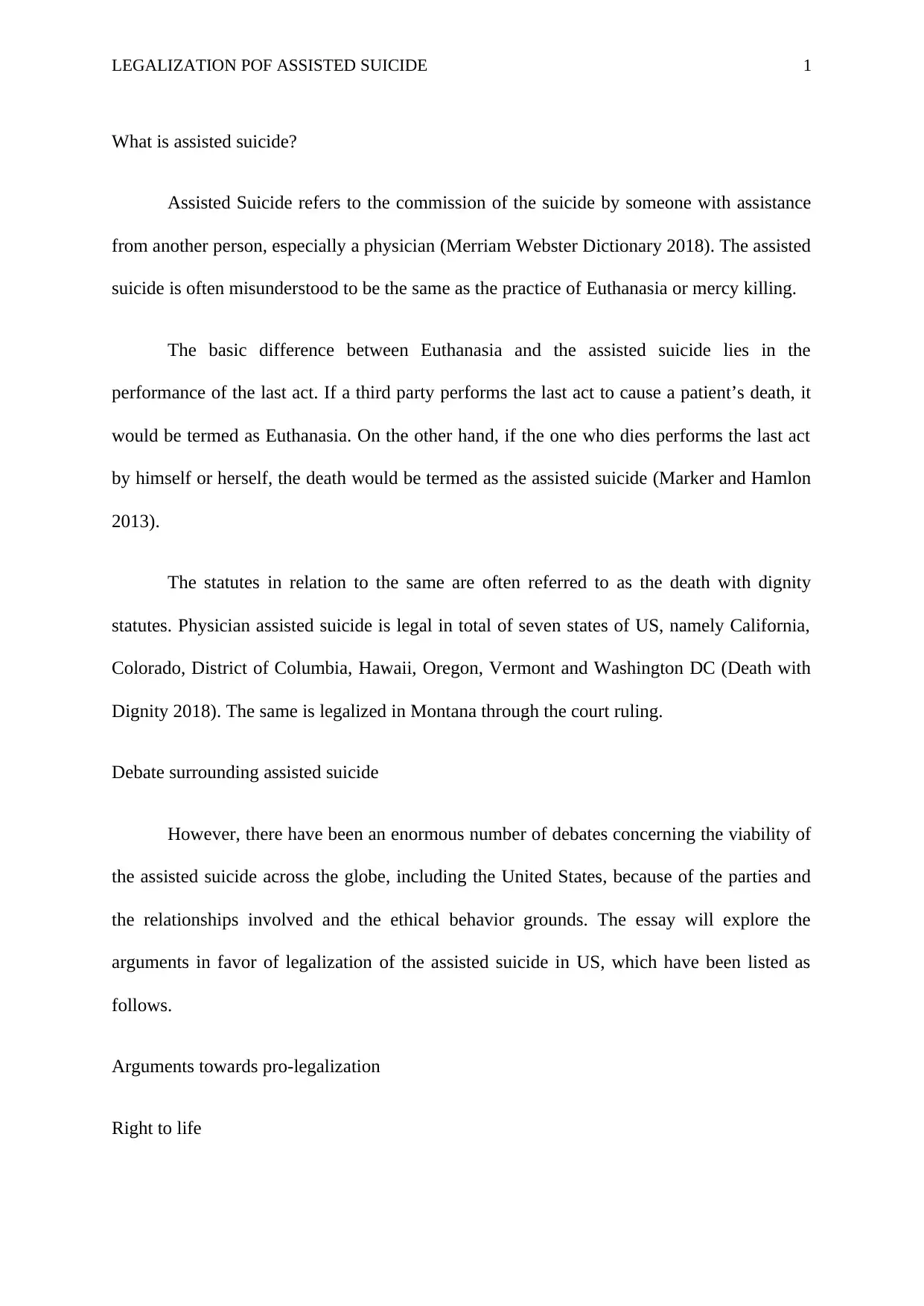
LEGALIZATION POF ASSISTED SUICIDE 1
What is assisted suicide?
Assisted Suicide refers to the commission of the suicide by someone with assistance
from another person, especially a physician (Merriam Webster Dictionary 2018). The assisted
suicide is often misunderstood to be the same as the practice of Euthanasia or mercy killing.
The basic difference between Euthanasia and the assisted suicide lies in the
performance of the last act. If a third party performs the last act to cause a patient’s death, it
would be termed as Euthanasia. On the other hand, if the one who dies performs the last act
by himself or herself, the death would be termed as the assisted suicide (Marker and Hamlon
2013).
The statutes in relation to the same are often referred to as the death with dignity
statutes. Physician assisted suicide is legal in total of seven states of US, namely California,
Colorado, District of Columbia, Hawaii, Oregon, Vermont and Washington DC (Death with
Dignity 2018). The same is legalized in Montana through the court ruling.
Debate surrounding assisted suicide
However, there have been an enormous number of debates concerning the viability of
the assisted suicide across the globe, including the United States, because of the parties and
the relationships involved and the ethical behavior grounds. The essay will explore the
arguments in favor of legalization of the assisted suicide in US, which have been listed as
follows.
Arguments towards pro-legalization
Right to life
What is assisted suicide?
Assisted Suicide refers to the commission of the suicide by someone with assistance
from another person, especially a physician (Merriam Webster Dictionary 2018). The assisted
suicide is often misunderstood to be the same as the practice of Euthanasia or mercy killing.
The basic difference between Euthanasia and the assisted suicide lies in the
performance of the last act. If a third party performs the last act to cause a patient’s death, it
would be termed as Euthanasia. On the other hand, if the one who dies performs the last act
by himself or herself, the death would be termed as the assisted suicide (Marker and Hamlon
2013).
The statutes in relation to the same are often referred to as the death with dignity
statutes. Physician assisted suicide is legal in total of seven states of US, namely California,
Colorado, District of Columbia, Hawaii, Oregon, Vermont and Washington DC (Death with
Dignity 2018). The same is legalized in Montana through the court ruling.
Debate surrounding assisted suicide
However, there have been an enormous number of debates concerning the viability of
the assisted suicide across the globe, including the United States, because of the parties and
the relationships involved and the ethical behavior grounds. The essay will explore the
arguments in favor of legalization of the assisted suicide in US, which have been listed as
follows.
Arguments towards pro-legalization
Right to life
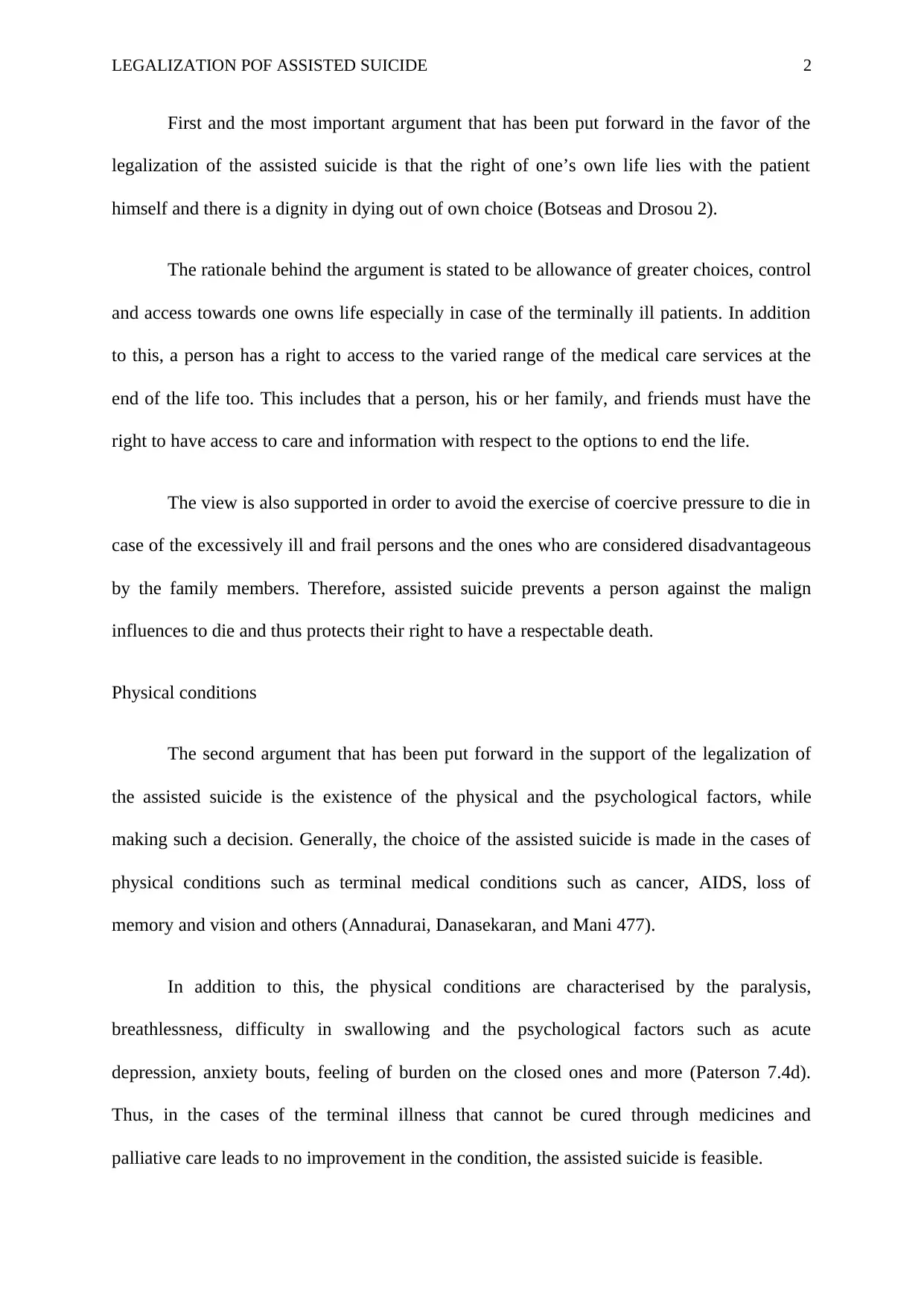
LEGALIZATION POF ASSISTED SUICIDE 2
First and the most important argument that has been put forward in the favor of the
legalization of the assisted suicide is that the right of one’s own life lies with the patient
himself and there is a dignity in dying out of own choice (Botseas and Drosou 2).
The rationale behind the argument is stated to be allowance of greater choices, control
and access towards one owns life especially in case of the terminally ill patients. In addition
to this, a person has a right to access to the varied range of the medical care services at the
end of the life too. This includes that a person, his or her family, and friends must have the
right to have access to care and information with respect to the options to end the life.
The view is also supported in order to avoid the exercise of coercive pressure to die in
case of the excessively ill and frail persons and the ones who are considered disadvantageous
by the family members. Therefore, assisted suicide prevents a person against the malign
influences to die and thus protects their right to have a respectable death.
Physical conditions
The second argument that has been put forward in the support of the legalization of
the assisted suicide is the existence of the physical and the psychological factors, while
making such a decision. Generally, the choice of the assisted suicide is made in the cases of
physical conditions such as terminal medical conditions such as cancer, AIDS, loss of
memory and vision and others (Annadurai, Danasekaran, and Mani 477).
In addition to this, the physical conditions are characterised by the paralysis,
breathlessness, difficulty in swallowing and the psychological factors such as acute
depression, anxiety bouts, feeling of burden on the closed ones and more (Paterson 7.4d).
Thus, in the cases of the terminal illness that cannot be cured through medicines and
palliative care leads to no improvement in the condition, the assisted suicide is feasible.
First and the most important argument that has been put forward in the favor of the
legalization of the assisted suicide is that the right of one’s own life lies with the patient
himself and there is a dignity in dying out of own choice (Botseas and Drosou 2).
The rationale behind the argument is stated to be allowance of greater choices, control
and access towards one owns life especially in case of the terminally ill patients. In addition
to this, a person has a right to access to the varied range of the medical care services at the
end of the life too. This includes that a person, his or her family, and friends must have the
right to have access to care and information with respect to the options to end the life.
The view is also supported in order to avoid the exercise of coercive pressure to die in
case of the excessively ill and frail persons and the ones who are considered disadvantageous
by the family members. Therefore, assisted suicide prevents a person against the malign
influences to die and thus protects their right to have a respectable death.
Physical conditions
The second argument that has been put forward in the support of the legalization of
the assisted suicide is the existence of the physical and the psychological factors, while
making such a decision. Generally, the choice of the assisted suicide is made in the cases of
physical conditions such as terminal medical conditions such as cancer, AIDS, loss of
memory and vision and others (Annadurai, Danasekaran, and Mani 477).
In addition to this, the physical conditions are characterised by the paralysis,
breathlessness, difficulty in swallowing and the psychological factors such as acute
depression, anxiety bouts, feeling of burden on the closed ones and more (Paterson 7.4d).
Thus, in the cases of the terminal illness that cannot be cured through medicines and
palliative care leads to no improvement in the condition, the assisted suicide is feasible.
⊘ This is a preview!⊘
Do you want full access?
Subscribe today to unlock all pages.

Trusted by 1+ million students worldwide
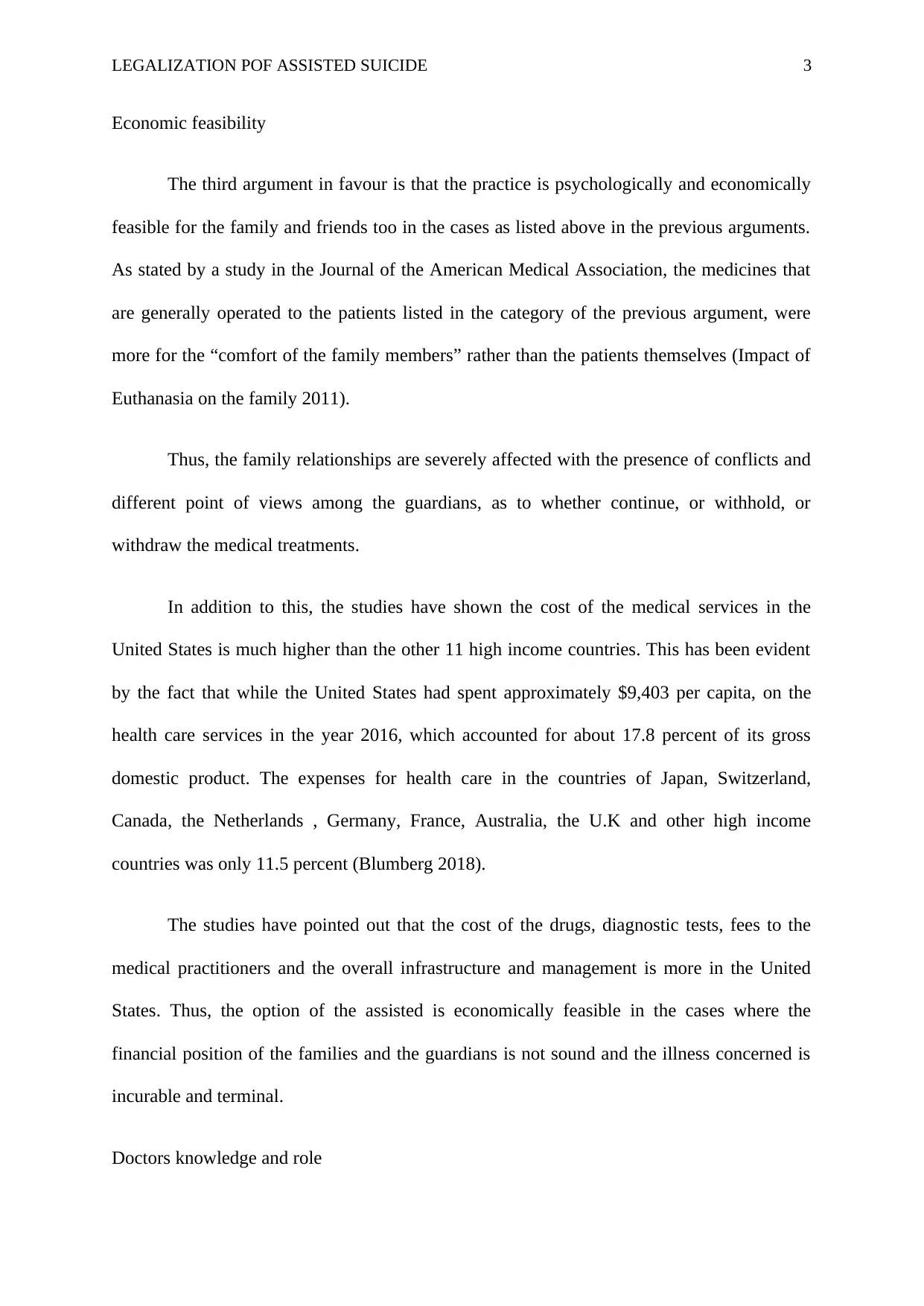
LEGALIZATION POF ASSISTED SUICIDE 3
Economic feasibility
The third argument in favour is that the practice is psychologically and economically
feasible for the family and friends too in the cases as listed above in the previous arguments.
As stated by a study in the Journal of the American Medical Association, the medicines that
are generally operated to the patients listed in the category of the previous argument, were
more for the “comfort of the family members” rather than the patients themselves (Impact of
Euthanasia on the family 2011).
Thus, the family relationships are severely affected with the presence of conflicts and
different point of views among the guardians, as to whether continue, or withhold, or
withdraw the medical treatments.
In addition to this, the studies have shown the cost of the medical services in the
United States is much higher than the other 11 high income countries. This has been evident
by the fact that while the United States had spent approximately $9,403 per capita, on the
health care services in the year 2016, which accounted for about 17.8 percent of its gross
domestic product. The expenses for health care in the countries of Japan, Switzerland,
Canada, the Netherlands , Germany, France, Australia, the U.K and other high income
countries was only 11.5 percent (Blumberg 2018).
The studies have pointed out that the cost of the drugs, diagnostic tests, fees to the
medical practitioners and the overall infrastructure and management is more in the United
States. Thus, the option of the assisted is economically feasible in the cases where the
financial position of the families and the guardians is not sound and the illness concerned is
incurable and terminal.
Doctors knowledge and role
Economic feasibility
The third argument in favour is that the practice is psychologically and economically
feasible for the family and friends too in the cases as listed above in the previous arguments.
As stated by a study in the Journal of the American Medical Association, the medicines that
are generally operated to the patients listed in the category of the previous argument, were
more for the “comfort of the family members” rather than the patients themselves (Impact of
Euthanasia on the family 2011).
Thus, the family relationships are severely affected with the presence of conflicts and
different point of views among the guardians, as to whether continue, or withhold, or
withdraw the medical treatments.
In addition to this, the studies have shown the cost of the medical services in the
United States is much higher than the other 11 high income countries. This has been evident
by the fact that while the United States had spent approximately $9,403 per capita, on the
health care services in the year 2016, which accounted for about 17.8 percent of its gross
domestic product. The expenses for health care in the countries of Japan, Switzerland,
Canada, the Netherlands , Germany, France, Australia, the U.K and other high income
countries was only 11.5 percent (Blumberg 2018).
The studies have pointed out that the cost of the drugs, diagnostic tests, fees to the
medical practitioners and the overall infrastructure and management is more in the United
States. Thus, the option of the assisted is economically feasible in the cases where the
financial position of the families and the guardians is not sound and the illness concerned is
incurable and terminal.
Doctors knowledge and role
Paraphrase This Document
Need a fresh take? Get an instant paraphrase of this document with our AI Paraphraser
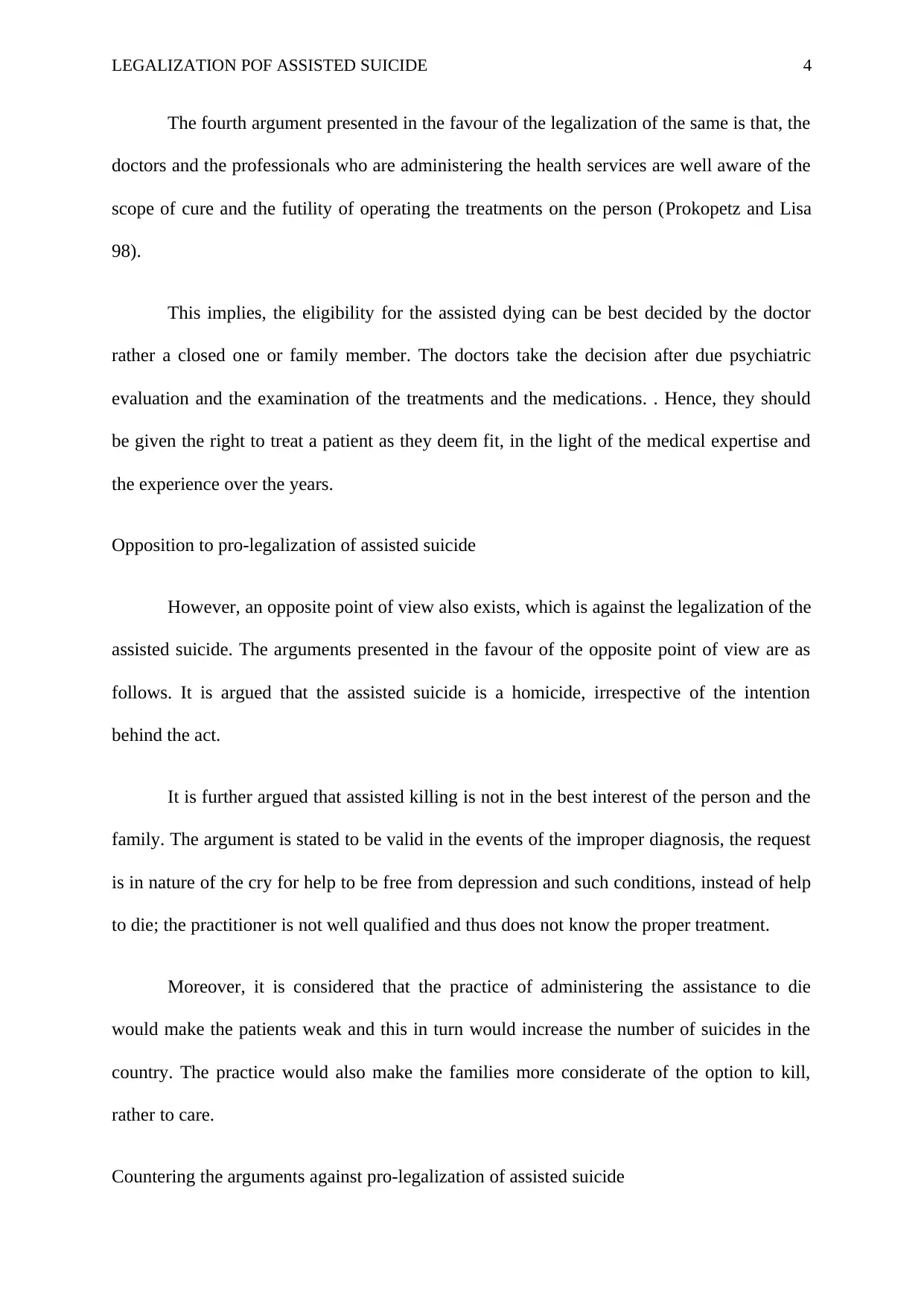
LEGALIZATION POF ASSISTED SUICIDE 4
The fourth argument presented in the favour of the legalization of the same is that, the
doctors and the professionals who are administering the health services are well aware of the
scope of cure and the futility of operating the treatments on the person (Prokopetz and Lisa
98).
This implies, the eligibility for the assisted dying can be best decided by the doctor
rather a closed one or family member. The doctors take the decision after due psychiatric
evaluation and the examination of the treatments and the medications. . Hence, they should
be given the right to treat a patient as they deem fit, in the light of the medical expertise and
the experience over the years.
Opposition to pro-legalization of assisted suicide
However, an opposite point of view also exists, which is against the legalization of the
assisted suicide. The arguments presented in the favour of the opposite point of view are as
follows. It is argued that the assisted suicide is a homicide, irrespective of the intention
behind the act.
It is further argued that assisted killing is not in the best interest of the person and the
family. The argument is stated to be valid in the events of the improper diagnosis, the request
is in nature of the cry for help to be free from depression and such conditions, instead of help
to die; the practitioner is not well qualified and thus does not know the proper treatment.
Moreover, it is considered that the practice of administering the assistance to die
would make the patients weak and this in turn would increase the number of suicides in the
country. The practice would also make the families more considerate of the option to kill,
rather to care.
Countering the arguments against pro-legalization of assisted suicide
The fourth argument presented in the favour of the legalization of the same is that, the
doctors and the professionals who are administering the health services are well aware of the
scope of cure and the futility of operating the treatments on the person (Prokopetz and Lisa
98).
This implies, the eligibility for the assisted dying can be best decided by the doctor
rather a closed one or family member. The doctors take the decision after due psychiatric
evaluation and the examination of the treatments and the medications. . Hence, they should
be given the right to treat a patient as they deem fit, in the light of the medical expertise and
the experience over the years.
Opposition to pro-legalization of assisted suicide
However, an opposite point of view also exists, which is against the legalization of the
assisted suicide. The arguments presented in the favour of the opposite point of view are as
follows. It is argued that the assisted suicide is a homicide, irrespective of the intention
behind the act.
It is further argued that assisted killing is not in the best interest of the person and the
family. The argument is stated to be valid in the events of the improper diagnosis, the request
is in nature of the cry for help to be free from depression and such conditions, instead of help
to die; the practitioner is not well qualified and thus does not know the proper treatment.
Moreover, it is considered that the practice of administering the assistance to die
would make the patients weak and this in turn would increase the number of suicides in the
country. The practice would also make the families more considerate of the option to kill,
rather to care.
Countering the arguments against pro-legalization of assisted suicide
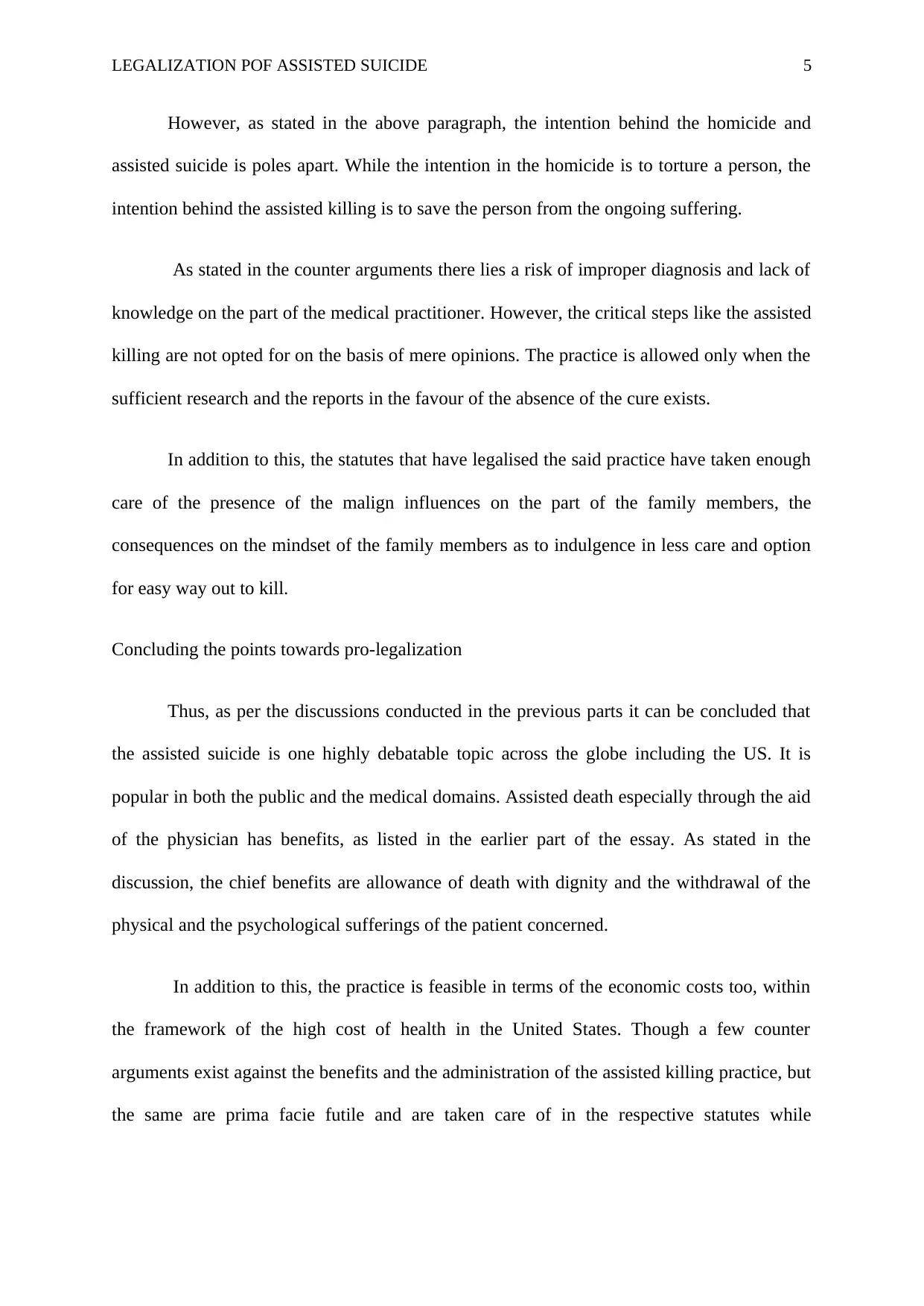
LEGALIZATION POF ASSISTED SUICIDE 5
However, as stated in the above paragraph, the intention behind the homicide and
assisted suicide is poles apart. While the intention in the homicide is to torture a person, the
intention behind the assisted killing is to save the person from the ongoing suffering.
As stated in the counter arguments there lies a risk of improper diagnosis and lack of
knowledge on the part of the medical practitioner. However, the critical steps like the assisted
killing are not opted for on the basis of mere opinions. The practice is allowed only when the
sufficient research and the reports in the favour of the absence of the cure exists.
In addition to this, the statutes that have legalised the said practice have taken enough
care of the presence of the malign influences on the part of the family members, the
consequences on the mindset of the family members as to indulgence in less care and option
for easy way out to kill.
Concluding the points towards pro-legalization
Thus, as per the discussions conducted in the previous parts it can be concluded that
the assisted suicide is one highly debatable topic across the globe including the US. It is
popular in both the public and the medical domains. Assisted death especially through the aid
of the physician has benefits, as listed in the earlier part of the essay. As stated in the
discussion, the chief benefits are allowance of death with dignity and the withdrawal of the
physical and the psychological sufferings of the patient concerned.
In addition to this, the practice is feasible in terms of the economic costs too, within
the framework of the high cost of health in the United States. Though a few counter
arguments exist against the benefits and the administration of the assisted killing practice, but
the same are prima facie futile and are taken care of in the respective statutes while
However, as stated in the above paragraph, the intention behind the homicide and
assisted suicide is poles apart. While the intention in the homicide is to torture a person, the
intention behind the assisted killing is to save the person from the ongoing suffering.
As stated in the counter arguments there lies a risk of improper diagnosis and lack of
knowledge on the part of the medical practitioner. However, the critical steps like the assisted
killing are not opted for on the basis of mere opinions. The practice is allowed only when the
sufficient research and the reports in the favour of the absence of the cure exists.
In addition to this, the statutes that have legalised the said practice have taken enough
care of the presence of the malign influences on the part of the family members, the
consequences on the mindset of the family members as to indulgence in less care and option
for easy way out to kill.
Concluding the points towards pro-legalization
Thus, as per the discussions conducted in the previous parts it can be concluded that
the assisted suicide is one highly debatable topic across the globe including the US. It is
popular in both the public and the medical domains. Assisted death especially through the aid
of the physician has benefits, as listed in the earlier part of the essay. As stated in the
discussion, the chief benefits are allowance of death with dignity and the withdrawal of the
physical and the psychological sufferings of the patient concerned.
In addition to this, the practice is feasible in terms of the economic costs too, within
the framework of the high cost of health in the United States. Though a few counter
arguments exist against the benefits and the administration of the assisted killing practice, but
the same are prima facie futile and are taken care of in the respective statutes while
⊘ This is a preview!⊘
Do you want full access?
Subscribe today to unlock all pages.

Trusted by 1+ million students worldwide

LEGALIZATION POF ASSISTED SUICIDE 6
legalization of the same. Thus, to conclude it can be said that everyone has right to life and
right to live respectably and according to his or her own will.
legalization of the same. Thus, to conclude it can be said that everyone has right to life and
right to live respectably and according to his or her own will.
Paraphrase This Document
Need a fresh take? Get an instant paraphrase of this document with our AI Paraphraser
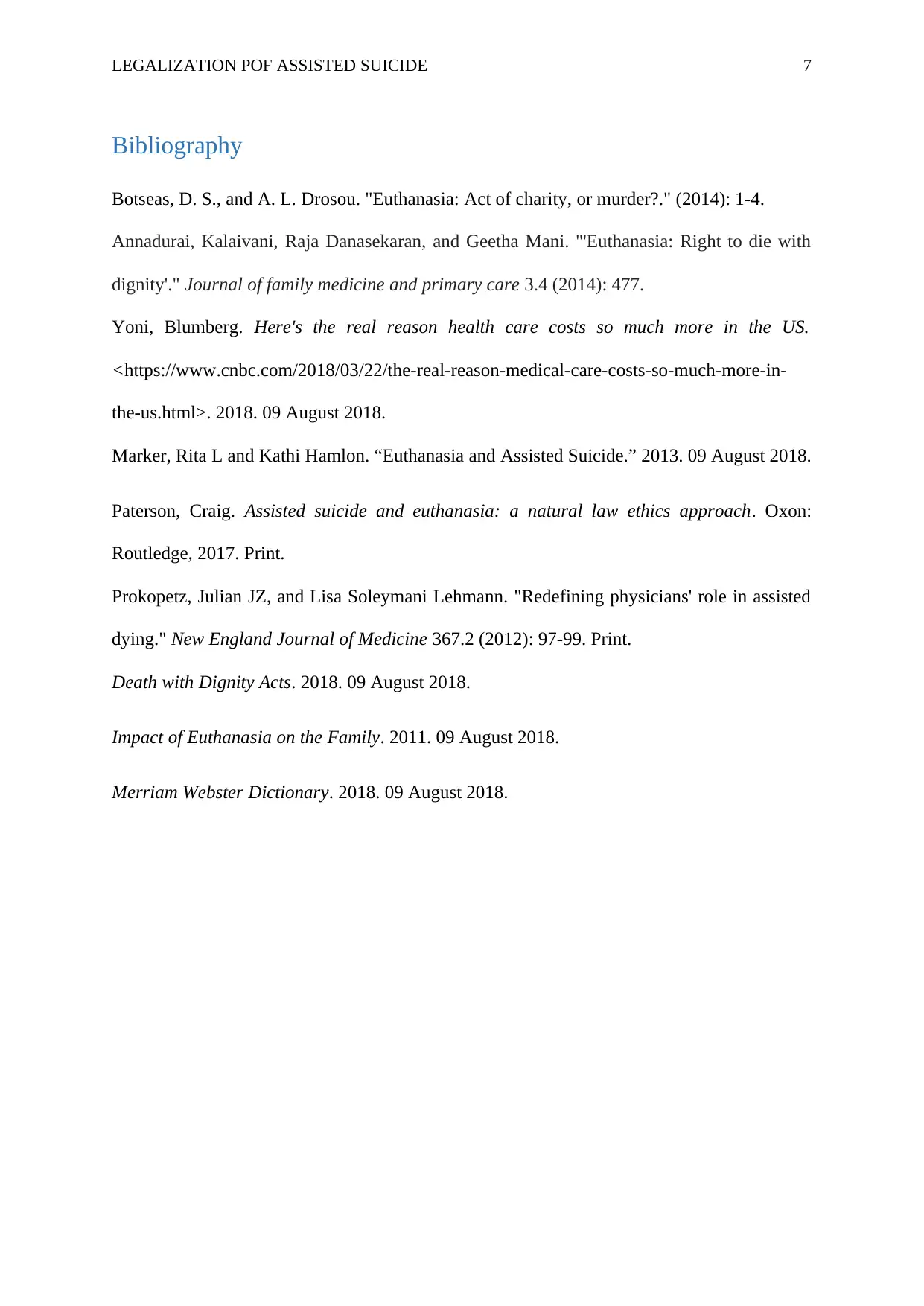
LEGALIZATION POF ASSISTED SUICIDE 7
Bibliography
Botseas, D. S., and A. L. Drosou. "Euthanasia: Act of charity, or murder?." (2014): 1-4.
Annadurai, Kalaivani, Raja Danasekaran, and Geetha Mani. "'Euthanasia: Right to die with
dignity'." Journal of family medicine and primary care 3.4 (2014): 477.
Yoni, Blumberg. Here's the real reason health care costs so much more in the US.
<https://www.cnbc.com/2018/03/22/the-real-reason-medical-care-costs-so-much-more-in-
the-us.html>. 2018. 09 August 2018.
Marker, Rita L and Kathi Hamlon. “Euthanasia and Assisted Suicide.” 2013. 09 August 2018.
Paterson, Craig. Assisted suicide and euthanasia: a natural law ethics approach. Oxon:
Routledge, 2017. Print.
Prokopetz, Julian JZ, and Lisa Soleymani Lehmann. "Redefining physicians' role in assisted
dying." New England Journal of Medicine 367.2 (2012): 97-99. Print.
Death with Dignity Acts. 2018. 09 August 2018.
Impact of Euthanasia on the Family. 2011. 09 August 2018.
Merriam Webster Dictionary. 2018. 09 August 2018.
Bibliography
Botseas, D. S., and A. L. Drosou. "Euthanasia: Act of charity, or murder?." (2014): 1-4.
Annadurai, Kalaivani, Raja Danasekaran, and Geetha Mani. "'Euthanasia: Right to die with
dignity'." Journal of family medicine and primary care 3.4 (2014): 477.
Yoni, Blumberg. Here's the real reason health care costs so much more in the US.
<https://www.cnbc.com/2018/03/22/the-real-reason-medical-care-costs-so-much-more-in-
the-us.html>. 2018. 09 August 2018.
Marker, Rita L and Kathi Hamlon. “Euthanasia and Assisted Suicide.” 2013. 09 August 2018.
Paterson, Craig. Assisted suicide and euthanasia: a natural law ethics approach. Oxon:
Routledge, 2017. Print.
Prokopetz, Julian JZ, and Lisa Soleymani Lehmann. "Redefining physicians' role in assisted
dying." New England Journal of Medicine 367.2 (2012): 97-99. Print.
Death with Dignity Acts. 2018. 09 August 2018.
Impact of Euthanasia on the Family. 2011. 09 August 2018.
Merriam Webster Dictionary. 2018. 09 August 2018.
1 out of 8
Related Documents
Your All-in-One AI-Powered Toolkit for Academic Success.
+13062052269
info@desklib.com
Available 24*7 on WhatsApp / Email
![[object Object]](/_next/static/media/star-bottom.7253800d.svg)
Unlock your academic potential
Copyright © 2020–2025 A2Z Services. All Rights Reserved. Developed and managed by ZUCOL.





